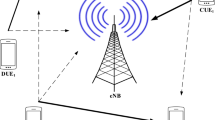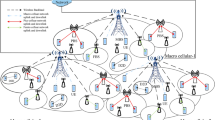Abstract
D2D (Device-to-Device) communication has become a crucial part of 4G and 5G networks. It can not only decrease the transmit power of user equipments (UEs) and increase area spectral efficiency of cellular networks, but also offload traffic from cellular networks and alleviate scarcity of spectrum resources by using in-band communication. In this paper, we consider a real tele-communication scenario in which the mobile UEs are primarily located in hotspots and cell edges. By integrating Poisson Hole Process with Thomas Cluster Process, a kind of D2D-Aided Underlaying Cellular Networks (D2D-UCNs) is built. In the D2D-UCNs, we first investigate the aggregation interference of the typical UE and D2D user by using stochastic geometry. Subsequently we analyze their coverage probability and area spectral efficiency. The simulation results show that the coverage probability of D2D users and UEs can be effectively guaranteed by establishing exclusion zone, whilst the area spectral efficiency of the D2D-UCNs can be maximized by optimizing the number of simultaneously active D2D links.






Similar content being viewed by others
References
Doppler, K., Rinne, M., Wijting, C., Ribeiro, C. B., & Hugl, K. (2009). Device-to-device communication as an underlay to LTE-advanced networks. IEEE Wireless Communications, 47(12), 42–49.
Lin, X., Andrews, J. G., Ghosh, A., & Ratasuk, R. (2014). An overview of 3GPP device-to-device proximity services. IEEE Communications Magazine, 52(4), 40–48.
George, G., Mungara, R. K., & Lozano, A. (2015). An analytical framework for device-to-device communication in cellular networks. IEEE Transactions on Wireless Communications, 14(11), 6297–6310.
Sakr, A. H., & Hossain, E. (2015). Cognitive and energy harvesting-based D2D communication in cellular networks: Stochastic geometry modeling and analysis. IEEE Transactions on Communications, 63(5), 1867–1880.
Haenggi, M. (2012). Stochastic geometry for wireless networks. Cambridge: Cambridge University Press.
Lin, X., Andrews, J. G., & Ghosh, A. (2014). Spectrum sharing for device-to-device communication in cellular networks. IEEE Transactions on Wireless Communications, 13(12), 6727–6740.
ElSawy, H., Hossain, E., & Alouini, M. S. (2014). Analytical modeling of mode selection and power control for underlay D2D communication in cellular networks. IEEE Transactions on Communications, 62(11), 4147–4161.
Sun, H., Wildemeersch, M., Sheng, M., & Quek, T. Q. (2015). D2D enhanced heterogeneous cellular networks with dynamic TDD. IEEE Transactions on Wireless Communications, 14(8), 4204–4218.
Xin, P. (2016). Research on D2D communication based on space poisson point process and social network [Dissertation]. Beijing: Beijing Jiaotong University.
Lin, X., Ratasuk, R., Ghosh, A., & Andrews, J. G. (2014). Modeling, analysis and optimization of multicast device-to-device transmissions. IEEE Transactions on Wireless Communications, 13(8), 4346–4359.
Feng, H., Wang, H., Xu, X., & Xing, C. (2014). A tractable model for device-to-device communication underlaying multi-cell cellular networks. In IEEE international conference on communications workshops, Sydney (pp. 587–591).
Zhong, Y., & Zhang, W. (2013). Muti-channel hybrid acess femtocells: A stochastic geometric analysis. IEEE Transactions on Communications, 61(7), 3016–3026.
Ganti, R. K., & Haenggi, M. (2009). Interference and outage in clustered wireless ad hoc networks. IEEE Transactions on Information Theory, 55(9), 4067–4086.
Afshang, M., Dhillon, H. S., & Chong, P. H. J. (2016). Modeling and performance analysis of clustered device-to-device networks. IEEE Transactions on Wireless Communications, 15(7), 4957–4972.
Afshang, M., & Dhillon, H. S. (2015). Spatial modeling of device-to-device networks: Poisson cluster process meets Poisson Hole Process. In 49th Asilomar conference on signals, systems and computers, Pacific Grove, CA (pp. 317–321).
Yazdanshenasan, Z., Dhillon, H. S., Afshang, M., & Chong, P. H. J. (2013). Poisson hole process: Theory and applications to wireless networks. IEEE Transactions on Wireless Communications, 15(11), 7531–7546.
Ganti, R. K., & Haenggi, M. (2006). Regularity in sensor networks. In IEEE international Zurich seminar on communications (pp. 186–189).
Folland, G. B. (2013). Real analysis: Modern techniques and their applications. Wiley: Academic Internet Publishers.
Afshang, M., Dhillon, H. S., & Chong, P. H. J. (2016). Fundamentals of cluster-centric content placement in cache-enabled device-to-device networks. IEEE Transactions on Communications, 64(6), 2511–2526.
Acknowledgements
This work was supported in part by the National Natural Science Foundation of China under grant 61572074, and by a project funded by Guizhou Key Laboratory of Electric Power Big Data, Guizhou Institute of Technology.
Author information
Authors and Affiliations
Corresponding author
Additional information
Publisher's Note
Springer Nature remains neutral with regard to jurisdictional claims in published maps and institutional affiliations.
Rights and permissions
About this article
Cite this article
Ma, Z., Nuermaimaiti, N. & Wang, L. Performance Analysis of D2D-Aided Underlaying Cellular Networks Based on Poisson Hole Cluster Process. Wireless Pers Commun 111, 2369–2389 (2020). https://doi.org/10.1007/s11277-019-06991-x
Published:
Issue Date:
DOI: https://doi.org/10.1007/s11277-019-06991-x




